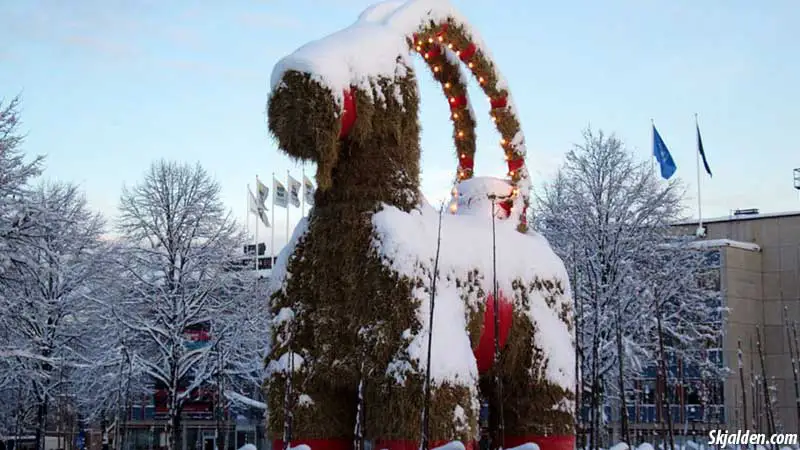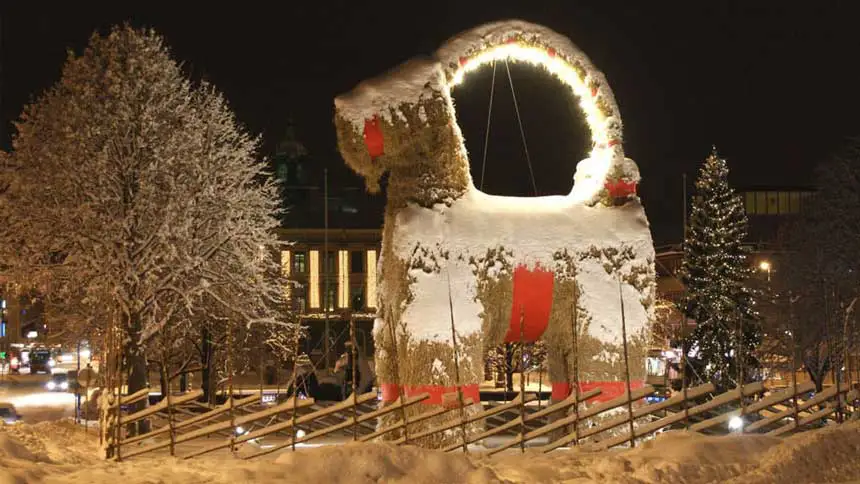The Swedes have many strange traditions and building a giant straw goat each year called Gävle goat is one of them. It is not an ancient tradition to put up a giant straw goat like this, and it is to my knowledge only something that is happening in the city of Gävle (158km north of Stockholm).
The straw goat is a traditional Swedish Yuletide decoration (”Christmas decoration”), although not in a giant size like this. Many Swedes, and some people from other parts of Scandinavia, typically decorate their houses with these small Yule goats, each year during December.
When Was the Gävle Goat First Built?
The history behind this particular straw goat in Gävle was to attract visitors to the shops and restaurants in the southern part of the city. It was on the first day of Advent in 1966, that this huge straw goat was placed at Castle Square for the first time, and since then, this Gävle goat has been a Yule symbol for people in and around the city.
Every year the local village of Mackmyra sends a truck full of straw, so they can recreate it for another Yule season. The goat’s measurements are 7 meters long, 13 meters (42.6 feet) high, and it weighs approximately 3.6 tonnes.
However, while this goat seems rather harmless in the eyes of most people, including my own. It has for some strange reason been the target of multiple attacks since it was put up for Yuletide for the first time in 1966.
The Repeated Attacks on Gävle’s Straw Goat
The Yule goat has been burned down numerous times, and it already started in the first year, when it was burned to the ground on the 31st of December. A few years later, they tried to protect the goat with some chicken-wire netting on the inside, but it was still burned.
The 1970s was probably not the goat’s favorite decade, not only was it burned, but it was also sabotaged, smashed to pieces, and even stolen. Some crazy Swede even drove his Volvo into the straw goat so it collapsed.
In 1979 after the first straw goat was burned to the ground, they made a second one, that was fireproofed. However, this attempt to protect it was in vain, and it met its fate when it got broken into pieces in December.
In 1985 the goat was featured in the Guinness Book of Records for the first time. This was also the year when 2 meters (6.6ft) high metal fence, was built around it, which was also guarded by security guards. Nevertheless, the straw goat burned to the ground in January.
In 1986 and onwards, two goats were built each year, one of them was made by the Southern Merchants, and the other one was made by the School of Vasa.
In 1988 people began to bet on its survival, when English bookmakers started to allow people to gamble on its fate. In 1992 both of the goats burned to the ground, the first one burned down only 8 days after its inauguration, and the second goat burned down on the 20th of December.
In 1994 the goat went on a trip when it followed the Swedish national hockey team to Italy for the World Championship in hockey.
In 1996 webcams were added, and you can still watch the straw goat from the comfort of your own home during December. At the beginning of the century, the goat was thrown into the Gävle River, and a year later it was burned to the ground by a Canadian, who got arrested for it. He spent 18 days in jail and was ordered to pay a fine of 100.000 Swedish kroner, he left the country without paying the fine.
In 2005 the straw goat was attacked and burned to the ground by a ground of people dressed as Santa, and the gingerbread man, who were shooting flaming arrows at the goat.
In 2010 the goat was lucky and avoided going up in flames after arsonists made an unsuccessful attempt to burn it. On the 17th of December, a Swedish news site reported that one of the security guards had been offered a bribe to leave his post. Allegedly, someone wanted to steal the goat via a helicopter and transport it to Stockholm.
In 2011 they tried to protect the goat by spraying water on it, to create a coating of ice, it burned down on the 2nd of December, just a few days after its inauguration.
At the straw goats’ 50th birthday party on the 27th of November in 2016, just a few hours after its inauguration, an arsonist equipped with petrol and a lighter burned it to the ground. The organizers said that they wouldn’t rebuild the goat this year. So it was replaced by a smaller replica built by local high school students. This goat was later hit by a car.
In 2018, a smaller version of the straw goat (In Swedish: Den Lilla Julbocken) that was standing near the main attraction was the victim of an arson attack. The person was of course arrested for it, while it might be a tradition for some people to attack the goat, it is not legal to do so, and I do not encourage you to do so either.
As you can see, the odds of its survival during December are not really that great, but it has survived the last two years. However, it has never survived three years in a row, and it might not make it through December this year.
Today this giant straw goat is known by many people around the world, and pictures of him have been spreading through many social media platforms for years. If you want to know more about the Gävle goat (in Swedish: Gävlebocken), you can follow him on Twitter and Instagram. You can also send him questions, at his email, gavlebocken@gavle.se. However, be patient, since he has many friends, and is on vacation most of the year.

Facts about the Gävle Goat
- The Gävle Goat has been inaugurated on the first Sunday of Advent, every year since 1966.
- The Gävle Goat is 13 meters (42.6 feet) high, 7 meters long, and weighs 3.6 tonnes.
- It takes a whole lorryload of straw from the village of Mackmyra to build the goat.
- The goat requires 1,600 meters of rope, with more than 12,000 knots.
- The goat’s straw coat is made from 56 five-meter straw mats.
- The goat’s wooden skeleton is made from 1,200 meters of Swedish pine wood.
- The construction of the goat takes more than 1,000 hours of labor.
- The goat has been the victim of numerous attacks, it has been burned down, and driven into by a cruising car.
- Since 1966 the goat has been damaged 37 times.
